What’s your craziest detour story?
The half-day round trip to see the world’s biggest ball of yarn that a roadside billboard made sound really exciting?
Or perhaps the decidedly less exciting excursion on a half-flat spare tire to find an open mechanic shop in the middle of the night?
Whatever it is, detours are a universal truth.
And that even extends to the information superhighway — aka the internet.
Small business owners, managers, and marketers must understand this is the new reality of the online customer journey.
Because of the non-linear nature of consumer interactions, it can be hard to figure out when to engage with shoppers, when to let them take the wheel, and how to encourage conversions, retention, and even referrals.
In the guide, we bring order to the mayhem and introduce a step-by-step process for building a customer journey map. We also cover the psychology of modern shoppers so you know how to optimize that map no matter how your goals or customers change.
Ready to hold your own and drive? (Obligatory Incubus reference!)
What the Heck Is a Customer Journey?
OK, OK, it’s probably not that mystifying.
The customer journey is the flow a person takes that begins with them becoming aware of your brand, product, or service online and ends with them making a purchase, completing an email list sign-up, or converting in some other way. Some businesses may take it a step further and add post-conversion touchpoints to the journey to make sure they’re nurturing their audience and creating loyal customers.
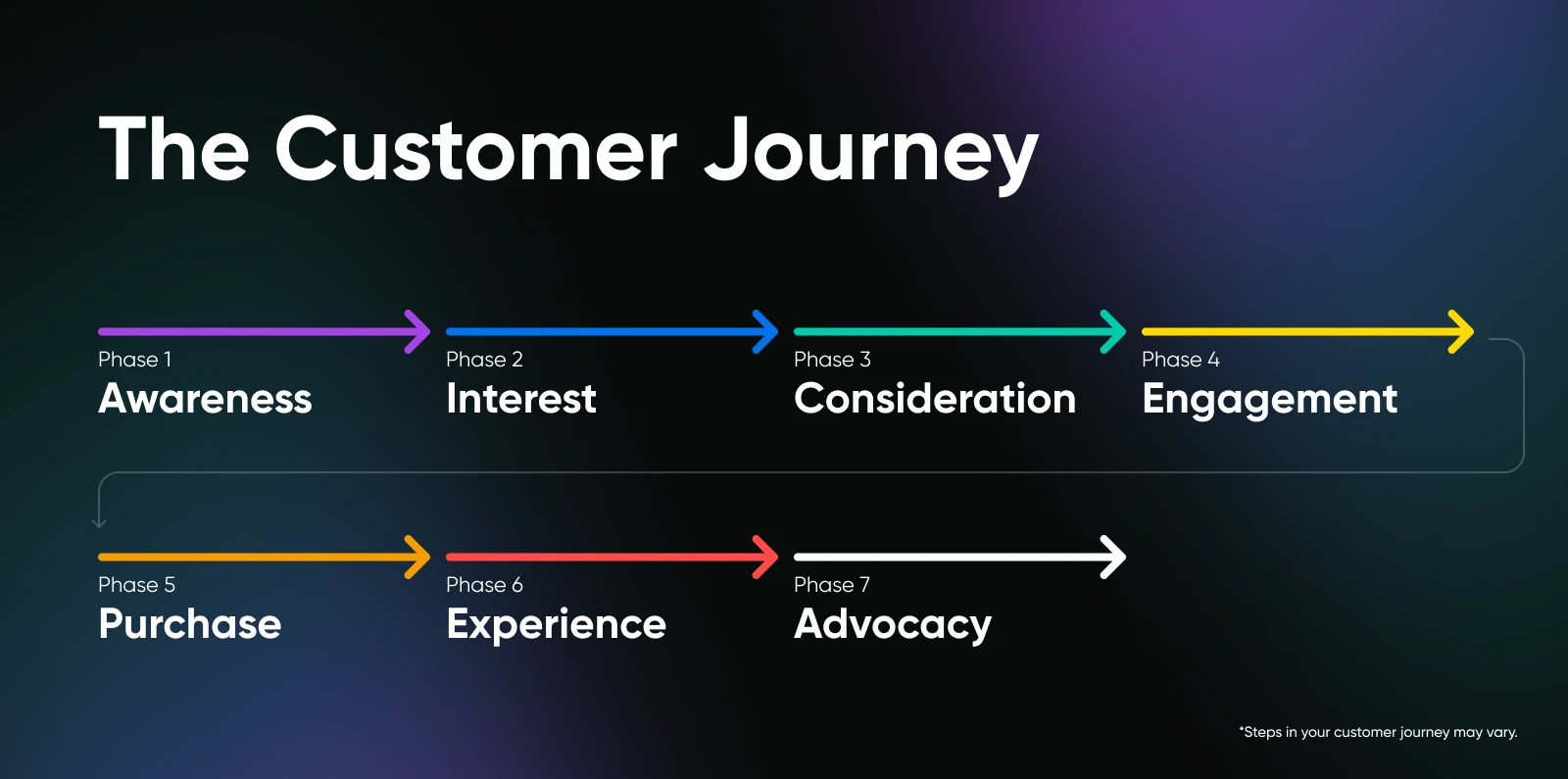
In this instance, touchpoints are where you interact directly or indirectly with a customer or potential customer throughout their journey. We’ll talk about these a lot more shortly, but common touchpoints include ads you run, blogs on your website, your checkout process, interactions with your customer service team, and so on.
Just like your road trip to visit family every holiday season, the customer journey is rarely completely linear. Different reasons for a detour crop up all the time — just like construction, snack breaks, and that flat tire that put you on the road four hours later than expected.
Customer journeys have become more complex mostly because of how the internet has connected everyday consumers to a vast world of knowledge.
Google’s consumer insights team has dubbed the area where linearity goes out the window as the messy middle.
In this middle is what they refer to as a “web of touchpoints” that change from consumer to consumer, influencing the decisions they make between awareness and purchase.
While you can’t really control which touchpoints consumers engage with anymore, that doesn’t mean the whole journey is chaos.
There is something you can approach methodically — your understanding of the customer journey and the steps you can take to improve it. In the next section, we’ll show you a step-by-step process (yay for our linear thinkers!) for building and optimizing your customer journey map.
And stay tuned because we’ll wrap up by circling back to the psychology behind consumer decision making in the messy middle, which will help you improve the customer experience map you’re about to build right…Now!
How To Create a Customer Journey Map in 7 Steps
A customer journey map is a visual tool that illustrates how consumers engage with and experience your website, products, or business across various touchpoints.
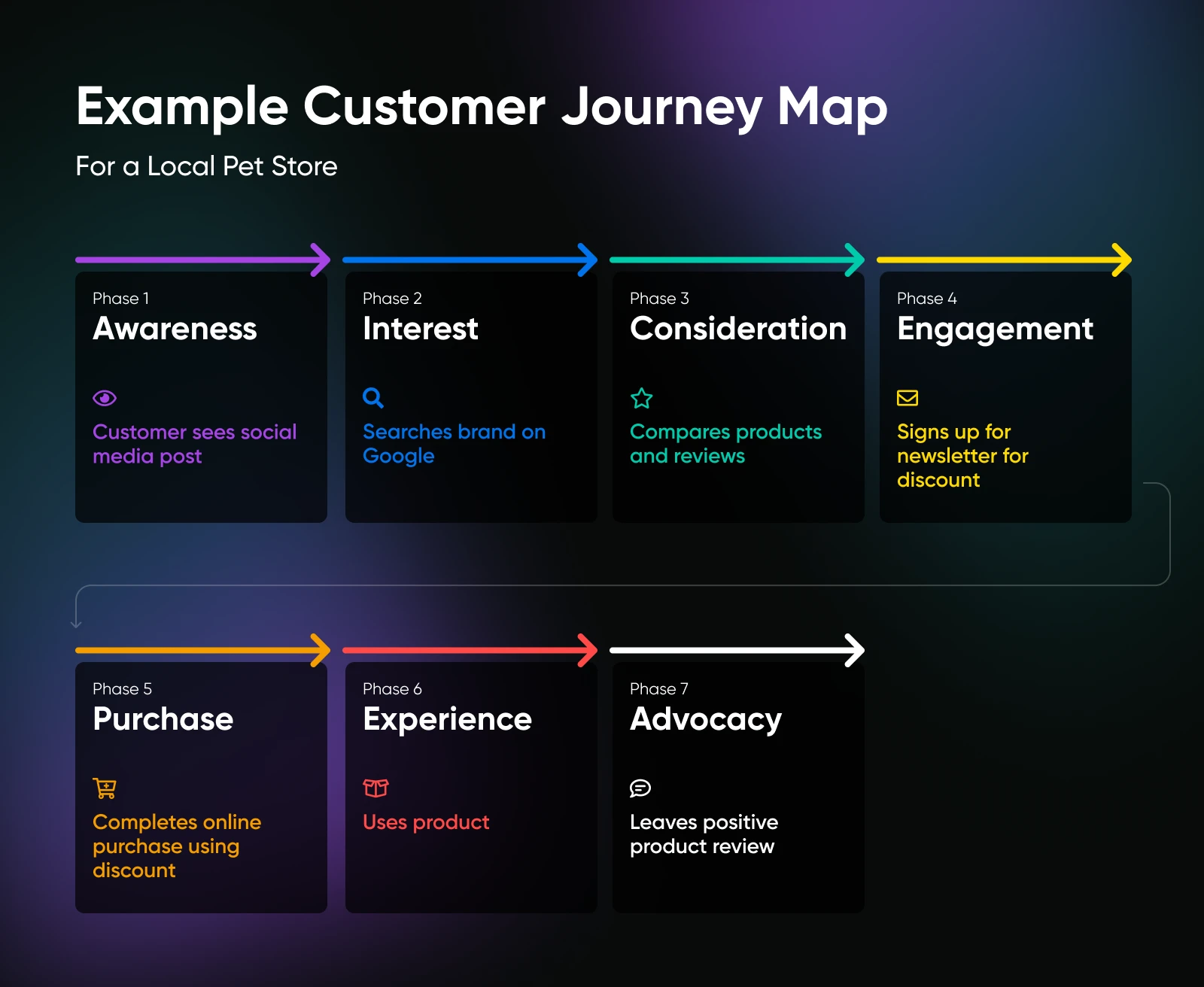
By mapping out the motivations and actions of your target shoppers, you gain a deeper understanding of customer satisfaction and what you can do to influence it in a favorable way for your brand. A thoughtful map is crucial for making the most informed, customer-centric, and eventually profitable decisions throughout the overall customer journey.
1. Determine the Goals of Your Customer Journey Map
Every successful journey starts with an endpoint in mind. Otherwise, how will you know if you’ve made progress?
So rather than creating a customer journey map just because you think you’re supposed to, determine what you aim to achieve and the specific experiences you want to highlight. Maybe you don’t want to overhaul your entire online presence but instead hope to hone in on a few quick-fix website issues.
As with any project, ensure your goals align with your company’s broader objectives, such as increasing revenue or improving customer retention. No point splashing out on a big customer journey reroute to generate new customers if your guiding business principle is building loyalty.
Finally, at this stage of the customer journey mapping process, you’ll want to establish relevant metrics to track progress. Like the mile markers along any road trip, these will tell you how fast and accurately you’re moving toward your goals.
2. Research How the Current Experience Works
Time to really dig in. Gather quantitative and qualitative data from internal and external sources to identify what’s actually happening during the customer journey.
This research should reveal insights into the types of buyers you attract, how they move through the buyer’s journey both off and on your website, and their feelings about their experiences. Bonus points if you can unveil how this compares to competitors’ flows.
Where does this information come from? Actual customer and shopper interviews, customer journey analytics from your website, feedback from customer support, surveys, social listening, and usability testing software with features like click tracking and heat mapping.
If you don’t already have a large base of active consumers who offer their feedback, consider creating a reward program to encourage engagement.
3. Profile Your Ideal Personas
The above research gave you insight into your real-life shoppers. From this, you can identify which customers you want to target and begin to develop realistic descriptions of them — aka, customer personas.
Persona
In marketing, a ‘persona’ is a fictional customer representing your target audience. Businesses use personas to understand ideal customers, tailoring strategies to improve sales approaches.
Read MorePersonas are detailed representations of your customer groups based on market research, website journey analytics, surveys, interviews, and other data sources.
The goal with personas is to understand the humans behind each touchpoint, so you can use marketing to solve their pain points and hit their motivational triggers to inspire conversions.
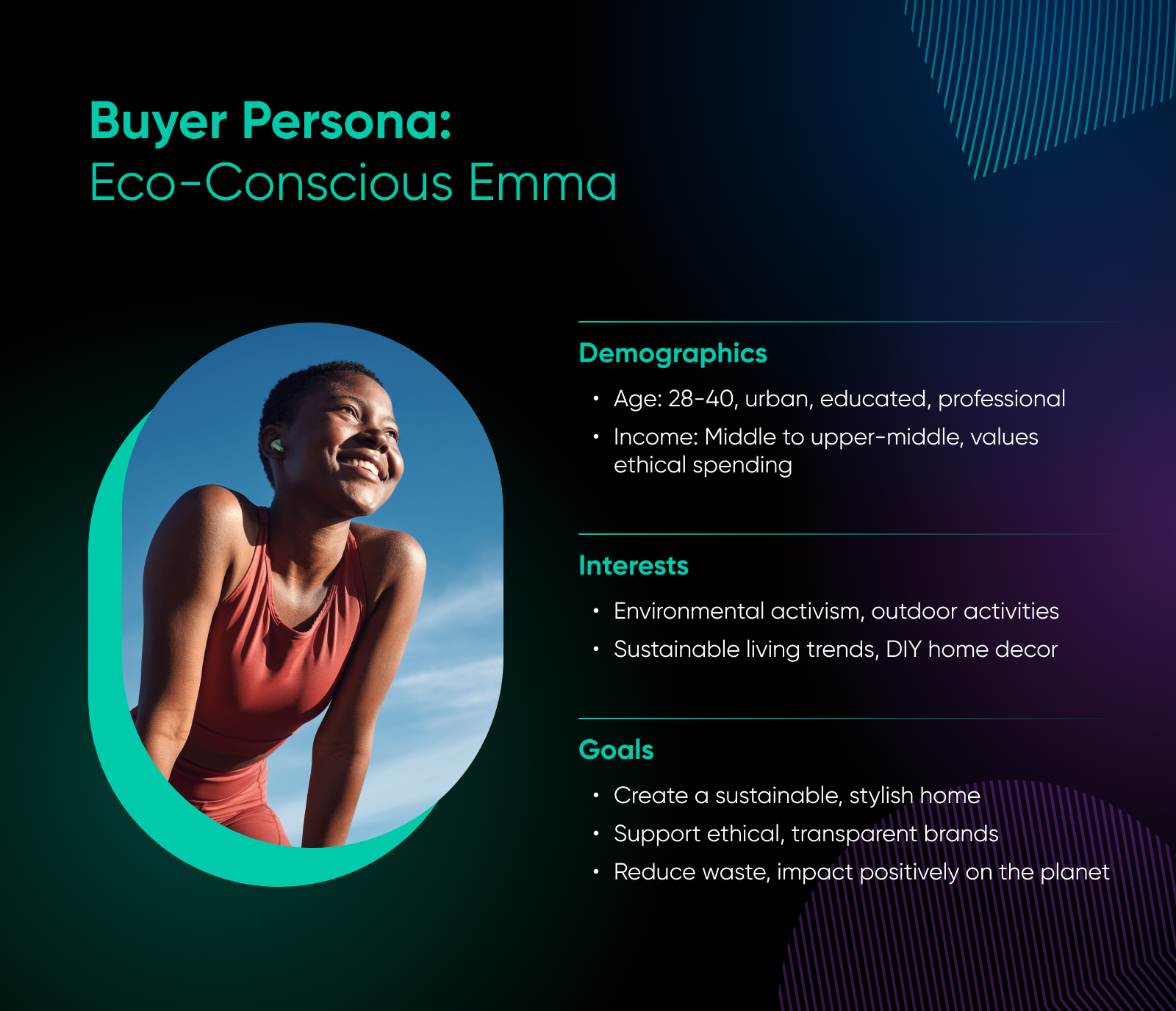
Luckily, there are lots of online guides to creating powerful personas. Here’s just one of many we found useful.
4. Detail All the Touchpoints You’ve Discovered
Time to start fleshing it out.
At this point, you’ve probably identified the areas where consumers interact with your brand — and even places you want to see interactions but don’t yet. These are what we’ve been referring to as your customer touchpoints. You’ll have a set of touchpoints for each customer group (aka persona) you target with your map. If you’re new to this, we recommend starting with just one persona — you can add others later.
These touchpoints will make up the skeleton of your customer journey map. They represent key times for your sales, marketing, and support staff (even if you’re the one who fills all of these roles at your small business!) to engage with and influence shoppers.
Consider all possible interaction points, including indirect ones like social media, review sites, etc. Right now, you’re not quite mapping out the customer journey, just putting each interaction on paper. Tactically, this could look like sticky notes placed on a whiteboard.
5. Map the Customer Journey: Current vs. Ideal
After identifying your target customer group and listing out all touchpoints, we’re finally ready to map the customer journey!
It’s time to arrange the above touchpoints in a logical order, based on your research, from awareness to purchase. As we mentioned, the entire customer journey is often not linear, so some touchpoints may overlap, repeat, and be hard to place. That’s OK; it’s more important that your map is functional than perfect looking.
If you went with the sticky notes route, draw a left-to-right timeline on your whiteboard (awareness > purchase) and place the notes along it.
As soon as your realistic customer journey map is complete, you’ll probably start to notice things.
You may observe repeated touchpoints, ignored touchpoints you want shoppers to hit, too many touchpoints in some areas (like the purchase process), and too few touchpoints in others (like the customer support flow).
Take a picture or otherwise copy the actual journey, and then rearrange your sticky notes until they reflect a customer experience that’s more ideal for both your company and the customers you’re trying to convert.
6. Put a Plan in Place To Go From Current > Ideal Journey
It’s about to get exciting — you’re going to turn that theoretical map into a real experience for customers!
This process will look different for everyone and depends on team size and business complexity. Because of that, we can’t tell you precisely how to implement your changes. What we can say is that it’s probably best to start at the axis of easy + impactful.
For example, for an individual selling on an e-commerce site, the most impactful and approachable journey may be the one that starts with the “Add to Cart” button. What touchpoints happen next, and what can you add or remove to make it faster and smoother?
Often, we find that businesses inject too many fields on the checkout page. Or, they’re not using this space to tap into innate biases many shoppers have (more on these next). So, adding badges of authenticity and free shipping for a limited time on this page could increase conversions.
Make a list of action items that will transform your customer journey map, and then order it by factors such as priority, attainability, and outcome. Assign due dates to each project to keep yourself accountable, and reach out to any design or development support you may need to make the bigger swings a reality.
7. Rinse and Repeat
Remember those goals and success metrics we set up earlier? Time to revisit them and see how your changes have moved you toward — or away from! — those.
The key to success is to keep measuring and iterating on your map. Trends change, customer needs change, and your map should also pivot to keep up. You may also refresh it as you introduce new offerings or make major overhauls to on- or off-site experiences.
If you took our advice to tackle one goal, persona, and journey at a time, be sure to go back and repeat this process to optimize the experience for as many customers as possible.
Bring It All Together with a Free Customer Journey Map Template
It can be difficult to picture what a working customer journey map may look like if you’ve never seen one. And truthfully, there’s no one right way to do it. So, here we’ve linked different types of editable customer journey templates to help you get started.
This free, editable map template for PowerPoint and Google Slides will help you chart touchpoints and customer sentiment throughout different phases of the journey — think awareness, consideration, purchase, and so on.
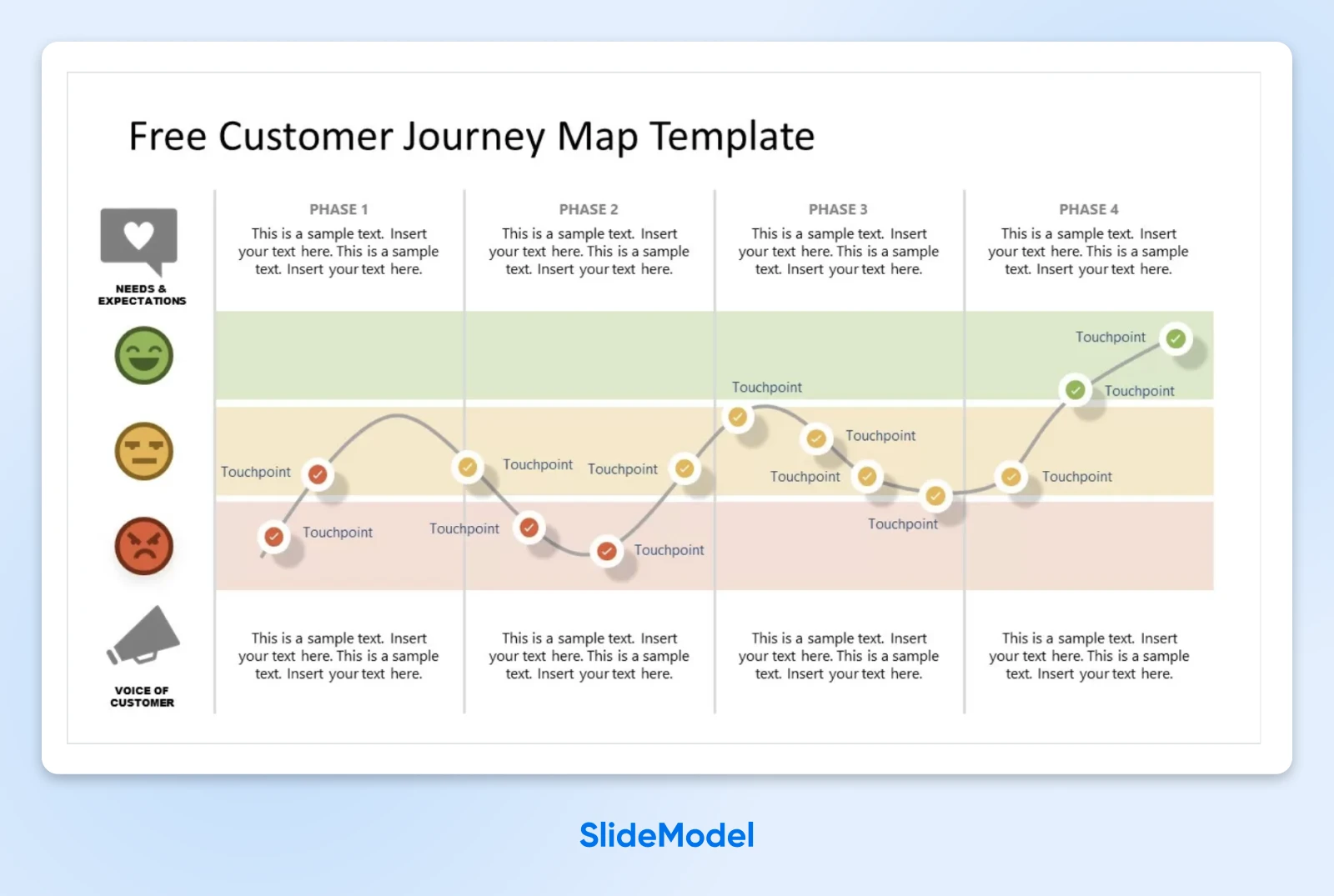
Canva is a visual editor with a free tier, where you can access many free customer journey map templates. We like this customer journey map whiteboard that details not just the journey but also customer pain points, actions, and solutions associated with each phase.
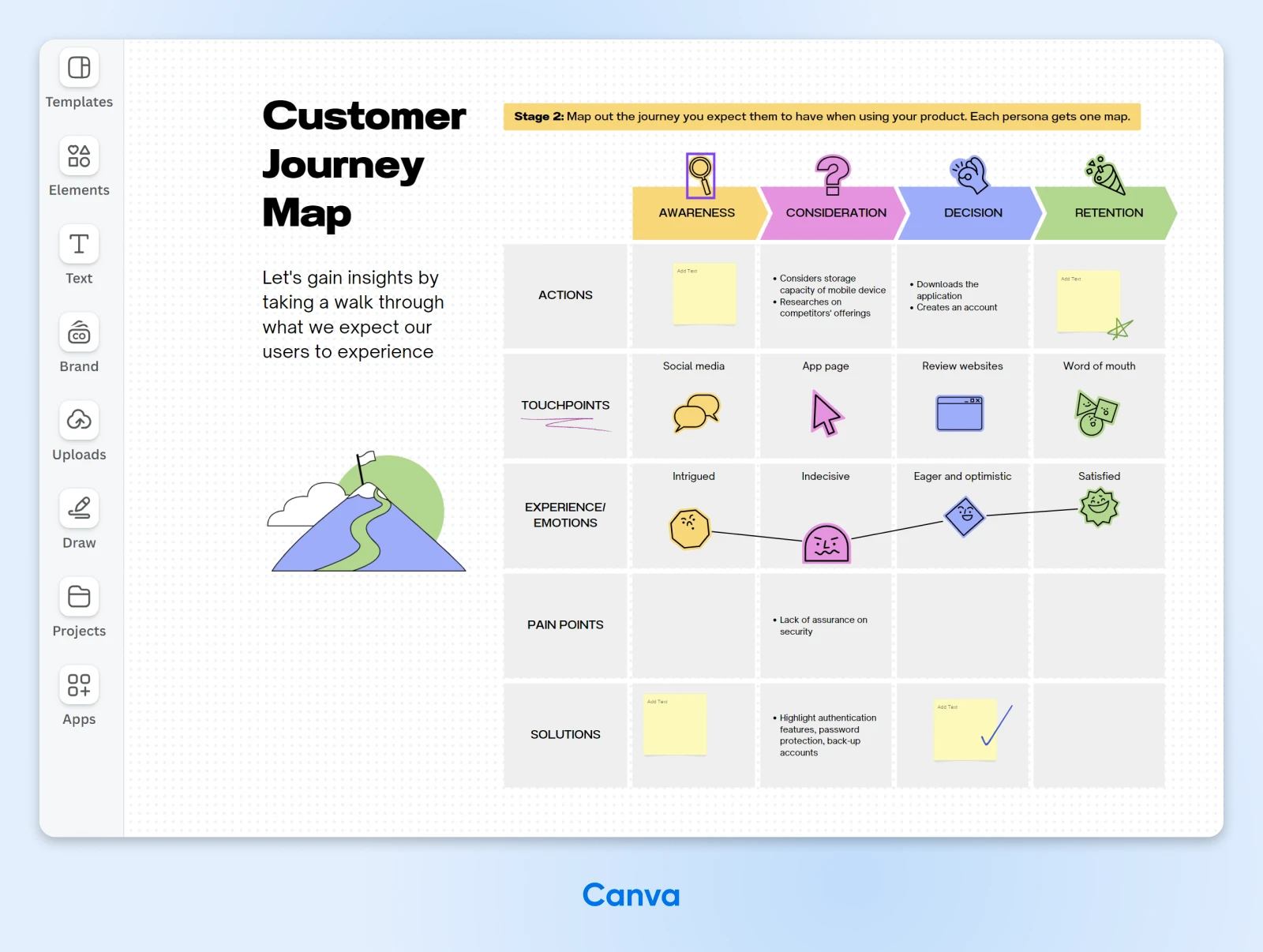
Visual Paradigm is an online builder with several free, editable, and downloadable customer journey templates. We like this option as it presents a creative, simple way to visualize the flow.
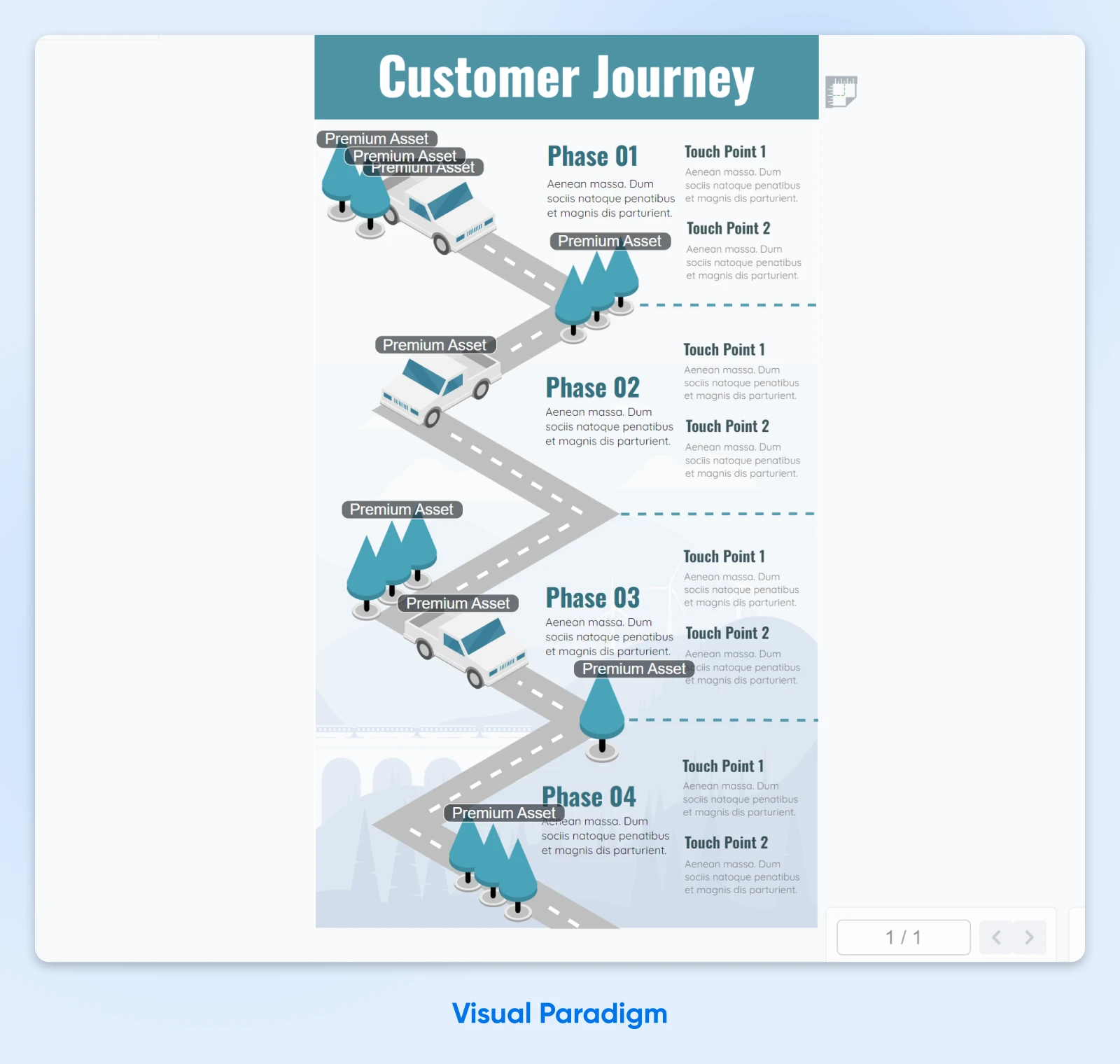
Keep in mind that using any premium assets on this program will result in watermarks on your final document.
The Key to Influencing the Modern Customer Experience: Psychology
While studying the messy middle we mentioned earlier, Google identified two core behaviors that most shoppers engage in before making a final decision:
- Exploration: Where the potential customer goes out and uses all the resources at their fingertips — search engines, social media, review sites, and even offline resources like books and in-person recommendations — to expand their knowledge about a topic or item.
- Evaluation: When a shopper begins to refine and reduce their options based on what they’ve learned through exploration, getting them closer to making the best purchase for their needs.
Google found that shoppers will navigate through these cycles of exploration and evaluation in the messy middle, repeating them as often as needed until they feel informed enough to reach a decision.
But how do they eventually break out of this loop to complete that all-important conversion?
Google took behavior science experts and dove even deeper into the customer journey mindset to discover that people deal with an overwhelming amount of data by relying heavily on cognitive biases and patterns ingrained in their psychology.
Understanding this core set of biases and patterns can help businesses pin down the customer journey and influence decisions at each touchpoint.
On that note, let’s cover these important biases and patterns and how to work with them to use human physiology to optimize customer experience and conversions.
Heuristic Thinking
Heuristics are a set of mental shortcuts people use to make decisions quickly when they don’t have the time or capacity to compare every single option.
Each person’s heuristic thought process or pattern is usually influenced by their biases. Getting to know your target personas, which you would have done in the above mapping process, is a great way to figure out what biases your target consumers may share.
For example, if your prospective customers have a tight budget, you might find they have a strong tendency to trust authority and social proof. If money is less of a concern than time is, they may have much more of a present bias (more on that later).
Heuristics are shortcuts, so they need to be visible, accessible, and highly digestible. Great touchpoints where you should consider heuristics include search engine ads, landing pages, comparison website pages, or blog posts.
Landing Page
A landing page is a singular web page that typically serves a unique marketing objective. For instance, this page may be designed to capture email leads or communicate a ‘coming soon’ message.
Read MoreFor example, a “My Product vs. My Main Competitor” article or page — use keyword research to find your most-searched competitor — can go a long way here.
Present/Presence Bias
Present bias, also known as presence bias, refers to people’s tendency to prioritize whatever option or outcome is right in front of them, or faster to achieve.
In marketing, making the most of this bias is partially about making your presence known in the places where potential customers spend a lot of time. If they’re on LinkedIn all the time, you should be on LinkedIn adding value and making your business known to your target audience.
You can also create marketing materials about how quick and easy it is for shoppers to get access to your offering, whether that means quick set up speed, fast shipping, etc. Or, look at all the touchpoints between awareness and purchase to make sure the flow is as smooth as possible to provide more instant gratification.
Social Proof
This pattern of thought occurs when shoppers validate their own opinions and actions based on customer feedback from others. Common sources of social proof include product testimonials, user reviews, etc.
If social proof really resonates with your audience, the good news is you can easily implement it throughout the journey. Post your best testimonials on your website’s homepage, feature happy customer quotes in blogs and ads, create slick video interviews of raving consumers for your YouTube and Instagram channels, and so on.
For example, the deodorant brand Lume posts testimonials on its front page.
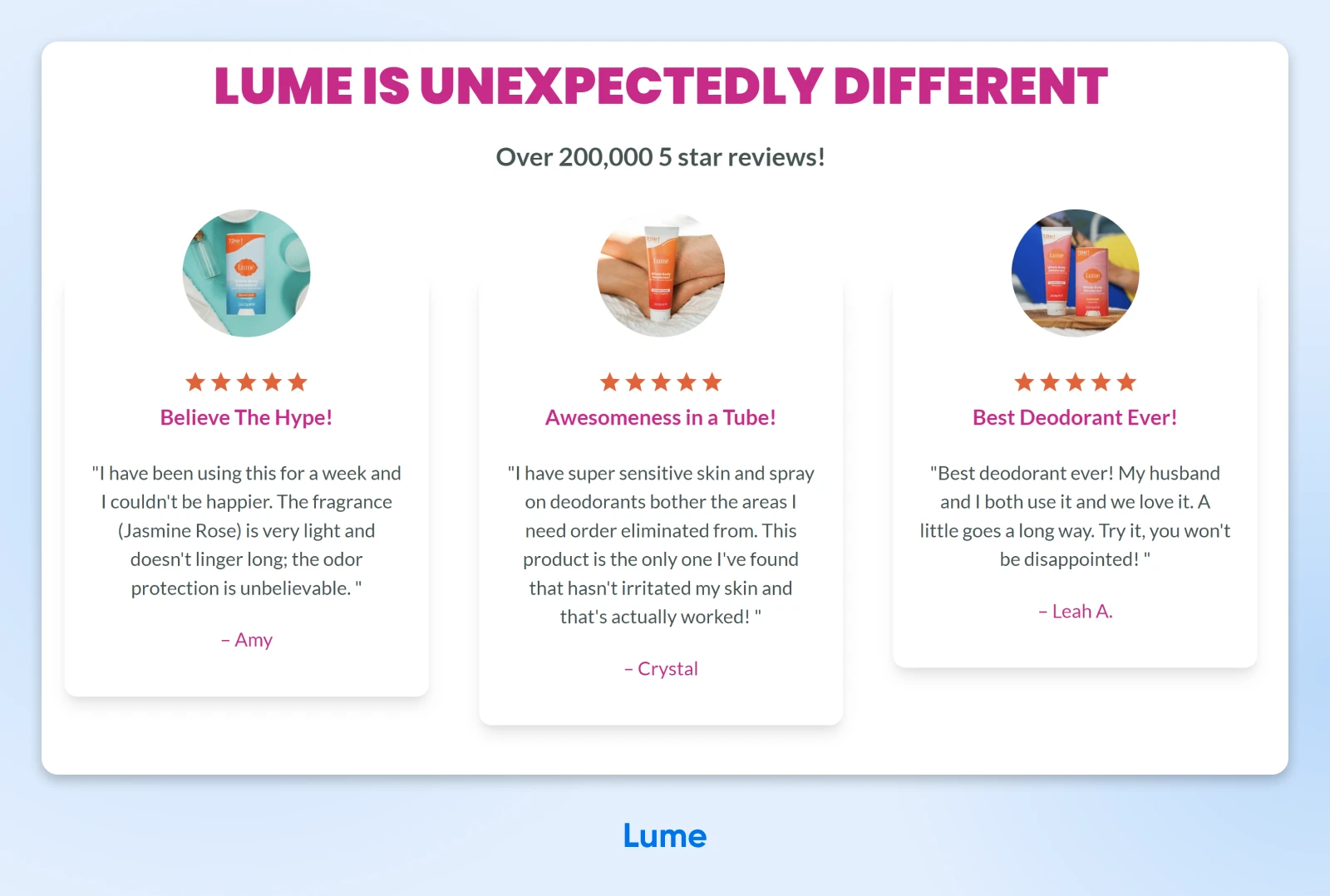
Don’t have enough customer content to pull this strategy off? Many brands offer rewards such as discounts and free shipping in exchange for reviews to drum up more input.
Scarcity Bias
This bias occurs when a product or resource becomes more desirable as its availability decreases. This behavior is thought to be rooted in the belief that limited quantity equates to higher value — everyone who wants the same thing can’t be wrong!
Today, many of us are familiar with the concept of FOMO (fear of missing out), and creating scarcity taps right into that fear.
Releasing limited editions, using low stock warnings, hosting sales with tight countdowns, and restricting availability to a group of “early birds” are all ways to ignite that scarcity bias at different touchpoints throughout your marketing.
Authority Bias
Authority bias is the common human tendency to be swayed by the judgments of people we consider authorities on a topic.
Examples of authorities in this instance include doctors, celebrities, and industry experts.
Similar to social proof, you can provide the authoritative voice people are looking for by getting quotes and other types of endorsements from recognized pros in your industry. You can also make the most of this bias by highlighting any credentials (awards, certifications, etc.) that position you or your business as an authority in your space.
Power of Free/Power of Zero
Even if you haven’t heard the adage “Vinegar that is free is sweeter than honey,” you probably get the idea behind it. Most of us are unduly attracted to free offers. This pattern of thinking can override other biases and logic to make us gravitate toward products and services with a free element.
But what could you offer for free without bleeding your bank account dry? Try common lead-generating resources that you only have to create once (ebooks, recorded webinars, etc.) but can offer indefinitely on your sales and marketing channels.
If you sell a digital product, is there a “mini” version people can sign up to use for free — or a way to incorporate a free trial that leads seamlessly to a paid subscription? If your product is physical, maybe you can offer a free sample, or free shipping, to get people to hit that purchase button more quickly? Both of these are places where it’s critical to minimize the number of touchpoints between awareness and conversion. There are only so many friction points a free offer can overcome before a bogged-down consumer gives up and goes elsewhere.
Ready to Crack the Code on Your Customer Journey Stages?
Understanding and optimizing your customer journey is core to driving business growth, improving the satisfaction of every customer, and ultimately boosting your bottom line.
By creating a comprehensive customer journey map, you gain invaluable insights into how your customers interact with your brand, allowing you to make data-driven decisions that enhance their experience at every touchpoint. Taking it a step further to leverage the psychological principles we’ve discussed will help you effectively influence your customers’ decisions.
For more tips on polishing up your marketing expertise and making your online customer journey shine, don’t miss some of our best marketing blogs, such as:
- How To Write Product Descriptions That Really Sell: 10 Tips
- Pay-Per-Click (PPC) Advertising: A Beginner’s Guide For Marketers
- 27 Ways To Grow Your Email List, Backed By Data
- 14 Practical Small Business Apps You Need To Know
- How To Write A Blog Post (10 Secrets To Success)

Get More Visitors, Grow Your Business
The best-designed site is worthless if no one can find it. Leverage proven online marketing strategies and techniques to help more of your target audience find you.
See More
